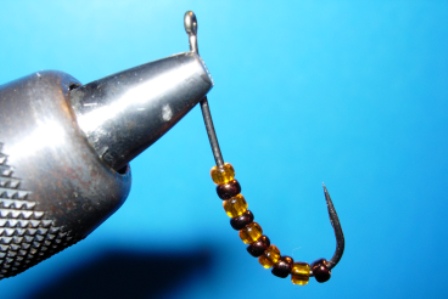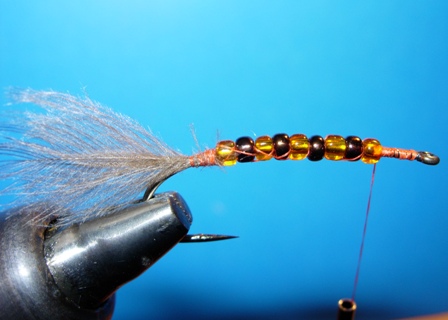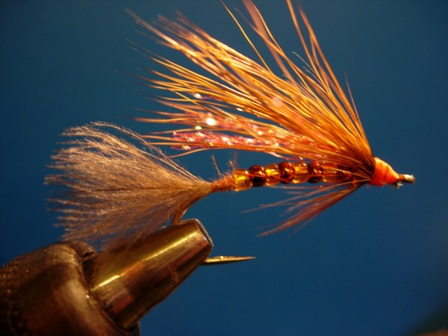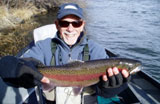Description
I owe this pattern to a couple of very
innovative good friends. A very long time
ago Joe Kimsey, guru of the Upper Sacramento
River and former owner of the Ted Fay Fly
Shop in Dunsmuir, created his famous
“Maggie” to imitate an emerging October
Caddis. I believe Joe may have gotten the
idea from Ted Fay. The Maggie is made of
orangish dubbing and trimmed deer hair.
Don’t be put off by its shaggy appearance
because that is intentional. Air bubbles are
trapped between the trimmed deer hair
strands, creating the suggestion of life—so
very important in any fly, but especially in
an emerger imitation. Many, many trout have
been caught on the Maggie—which, of course,
is the proverbial proof of the pudding.
But over time patterns morph, partly in
response to changing fish reaction to
patterns that they have seen a lot, and
partly because we fly tiers are constantly
tinkering in the exercise of our personal
creativity. Ron Rabun’s Crystal Maggie is a
good example of a creative tyer adapting to
changing conditions with a “revision” of a
long-standing fly pattern. Ron’s pattern
incorporates most of the qualities of the
Maggie, but includes some of his own
designs. A few of Ron’s changes include the
addition of crystal flash with the wing,
some ribbing, and a furnace-type hackle at
the front. Again, the results prove the
theory; the Crystal Maggie has brought many
a fish to the nets of anglers, including me.
My own version, which I call “Bill’s
Emerging Thing,” is based on both the Maggie
and the Crystal Maggie. I changed the color
of the deer hair “wing,” used tiny glass
beads for the body, and added a shuck made
of CDC. I’ve been testing this fly for
several years and am now convinced that it
is a fish-catcher, having caught a good
number of large fish with it during the fall
season of 2008.
Tying Instructions
|
-
Smash hook barb thoroughly—this
is necessary (aside from normal
barbless reasons) in order to
slide the glass seed beads onto
the hook.
-
Place the hook in the vise with
the bend facing down and slide
an orange bead over the point
and around the bend. Follow this
with a root beer bead. Continue
with alternating colors until
the shank is half covered with
beads. Reposition the hook in
the vise in the normal position.
|

|
|
|
|
-
Mount the thread at the eye and
wrap it back to the 1/3 point on
the shank. Push the beads
forward to the 1/3 point and
begin wrapping the thread
rearward between the beads. Keep
the forward pressure on the
beads in order to keep them from
sliding too far to the rear.
Build a thread dam behind the
last of the beads to keep them
in place. You should, at this
point, have sufficient room to
tie in the CDC tail. Return the
thread to the 1/3 point on the
shank.
-
Match two CDC feathers and pinch
them between your thumb and
forefinger. Measure them to 2/3
of the length of the shank and
tie the tips in as a tail—in
reality a shuck representation.
|
 |
|
|
|
-
Dub a small thorax of orange dubbing
material just ahead of the front
bead, leaving room for the wing,
hackle, and a small head.
-
Tie in several strands of orange crystal
flash as an under wing. Top this with a
small bunch of burnt orange deer hair.
Don’t stack the hair. Using a black
Sharpie, make a strip along the top of
the deer hair wing. Apply a tiny drop of
super glue to the tie-in point.
|
 |
|
|
|
-
Tie in a furnace hackle at the
same point. Take 3 or 4 wraps
and tie it off. Form a nice
small head and whip finish.
|
 |
|
|
|
|
Tying
& Fishing Tips
1.
As mentioned in the text above,
don’t stack the hair—just pull
out the “wild” strands so that
the tips of the remaining
strands are fairly close in
length. This gives the fly a
more sleek profile that gives
the impression of life.
2.
Don’t use a lot of flash;
it is unnecessary and can scare
fish, especially in low-water
fall conditions.
3.
Fish the fly on the
dropper with a Stick Caddis on
the point, and perhaps even a
“stinger” tied to the bend of
the Stick Caddis. Allow the fly
to swing through a normal short
line drift, and then let it
swing below you where it will
rise in the water column and
resemble a hatching October
Caddis.
|
|
|
|
|
 |
|

